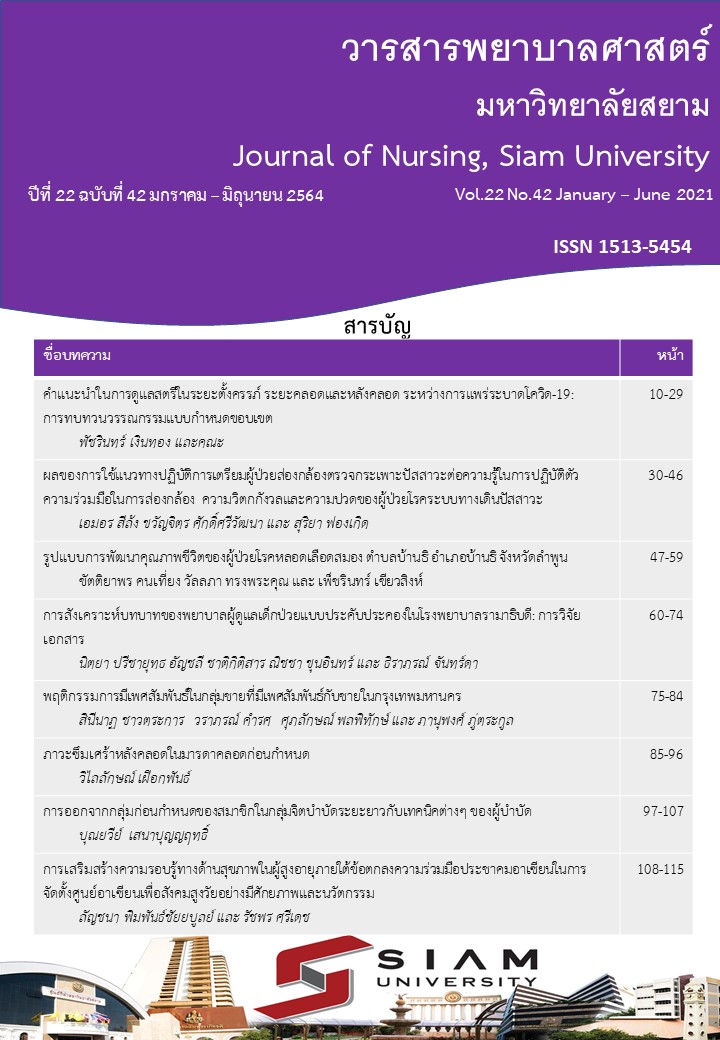Model of Quality of Life Development for Patients with Cerebrovascular Diseases of Banthi subdistrict, Banthi district, Lumphun province
Keywords:
Quality of Life, Stroke patient, Model of Quality of Life DevelopmentAbstract
This study aims to examine a model of quality of life development for patients with cerebrovascular diseases of Banthi Subdistrict, Banthi District, Lumphun Province. The samples are thirteen stroke-patients and thirteen principal-caregivers, including fifteen key informants. Data was collected using Stroke Impact Scale: SIS) Thai version questionnaire (Khampolsiri, Pothiban, Sucamvang, & Panuthai, 2006), in-depth interviews, and group discussion related to ECCM components. Wilcoxon Signed-Rank test and descriptive data were used to analyze data.
Finding illustrated that the model of quality of life development for patients with cerebrovascular diseases of Banthi Subdistrict, Banthi District, Lumphun Province was consistent with the community’s context. Steakholders in the community concern about the significances of quality of life development continuously and efficiency. The result showed significant difference between mean score at pretest and posttest of hand function (p< 0.05). However, there were no differences between mean scores at pretest and posttest of other components, strength, communication, memory, emotion, social participation, activity of daily living, and mobility.
In conclusion, stakeholders in the community Banthi Subdistrict, Banthi District, Lumphun Province were satisfied with the model of quality of life development for patients with cerebrovascular diseases, cooperated with continuous improvement of quality of life. Health care team had a model for implementing continuously and systematically, consistency with community context. Moreover, a guideline for quality of life development for patients with cerebrovascular diseases from this study can be applied for further study in special care of specific aspect, especially, for patients in rehabilitation phase.
References
กองโรคไม่ติดต่อ กรมควบคุมโรค กระทรวงสาธารณสุข. (2563). รายงานสถานการณ์โรค NCDs เบาหวาน ความดันโลหิตสูง และปัจจัยเสี่ยงที่เกี่ยวข้อง พ.ศ. 2562.กรุงเทพฯ: สำนักพิมพ์อักษรกราฟฟิคแอนด์ดีไซน์.
ภารดี เหรียญทอง, วิไลวรรณ ทองเจริญ, นารีรัตน์ จิตรมนตรี, และวิชชุดา เจริญกิจการ. (2558). ประสิทธิผลของโปรแกรมการสร้างเสริมพลังอำนาจต่อพฤติกรรมสุขภาพของผู้สูงอายุโรคหลอดเลือดสมอง. วารสารพยาบาลสงขลานครินทร์, 35 (ฉบับพิเศษ): เดือนกันยายน – ธันวาคม, 143-158.
รัชวรรณ สุขเสถียร. (2557). การเข้าถึงบริการเวชกรรมฟื้นฟูโรคหลอดเลือดสมองระยะเฉียบพลันแบบผู้ป่วยใน ณ โรงพยาบาลมหาราชนครราชสีมา: ปัจจัยที่เกี่ยวข้องและผลลัพธ์. เวชศาสตร์ฟื้นฟูสาร, 24(2), 37-43.
รังสิยา นารินทร์ และคณะฯ .(2557). รายงานการศึกษาวิจัยถอดบทเรียนการขับเคลื่อนนโยบายสาธารณะเพื่อสุขภาพแบบมีส่วนร่วมให้เกิดผลอย่างเป็นรูปธรรม ตำบลห้วยยาบ อำเภอบ้านธิ จังหวัดลำพูน. เชียงใหม่: สยามพิมพ์นานา.
สมบัติ น้ำดอกไม้ (2558) . ผลของโปรแกรมการพยาบาลตามรูปแบบความเชื่อความเจ็บป่วยต่อความเครียด และการดูแลสุขภาพผู้ป่วยโรคหลอดเลือดสมองของครอบครัวผู้ดูแล. วิทยานิพนธ์พยาบาลศาสตรมหาบัณฑิต, บัณฑิตวิทยาลัย,มหาวิทยาลัยบูรพา.
Khampolsiri T, Pothiban L, Sucamvang K, & Panuthai S. (2006). A Home-based Nursing Intervention for Enhancing Quality of Life of Stroke Survivors. Chula Med J, 50, 707–725.
World Health Organization. (2015). World Stroke Campaign. Retrieved 8 Dec 2020, from http://www.world-stroke.org.
World Stroke Organization. (2019). (WSO): Global Stroke Fact Sheet 2019. Retrieved 10 Jan 2021, from https://www.world-stroke.org/ assets/ downloads/ WSO_Fact-sheet_15.01.2020.pdf.
Downloads
Published
How to Cite
Issue
Section
License
Content and information published in the Journal of Nursing, Siam University is the comment and responsibility of the authors.
Articles, information, images, etc. published in the Journal of Nursing. Siam University is the copyright of the Journal of Nursing, Siam University. If any person or entity wants to take all or part of it for publication for any purposes, please reference the Journal of Nursing, Siam University.



